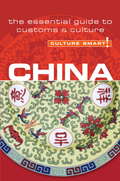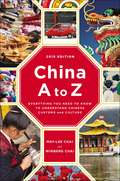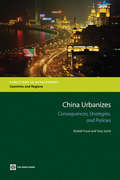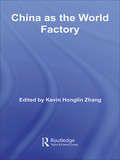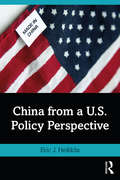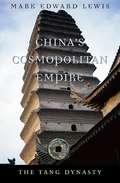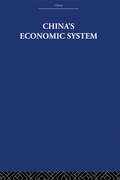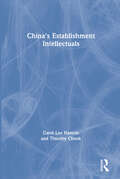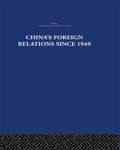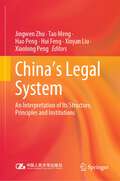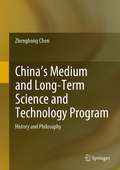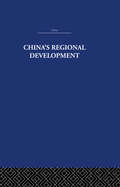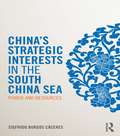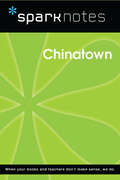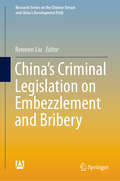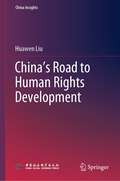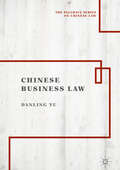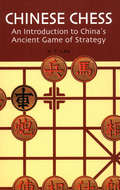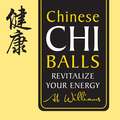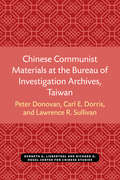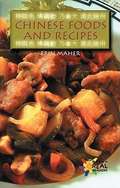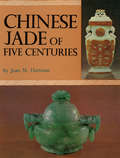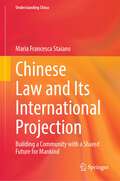- Table View
- List View
China - Culture Smart!
by Kathy FlowerThe spectacular Beijing Olympics of 2008 signalled China's arrival as a superpower on the world stage. The global economic crisis that followed in 2008-9 saw it become banker to the West, poised to eclipse the United States. This new edition of Kathy Flower's bestselling Culture Smart! China has been revised and updated by the author to take on board the transformation in China's fortunes and the changing face of Chinese society. As China flexes its economic and political muscle abroad, ordinary people feel a new pride in their country's achievements. The embrace of free-market capitalism by the communist state has spread prosperity to many, with fortunes being made by some. But it has created losers as well as winners, particularly in the countryside. Gone is the security of the state's "iron rice bowl" provision for life, and unemployment or dispossession have opened up social gaps that could threaten its stability. For the moment the rumbling discontent is below the radar and under control, and for millions the Chinese virtues of enterprise, industry, and patience are paying handsome dividends. This edition of Culture Smart! China is completely revised, making it the indispensable visitors' guide to the complexities of a rapidly changing world power whose ancient culture and traditions owe little to the West.
China A to Z
by Winberg Chai May-Lee ChaiA practical and accessible guide to an ancient but rapidly changing culture Perfect for business and armchair travelers alike, China A to Z explains the customs, culture, and etiquette essential for any trip or for anyone wanting to understand this complex country. In one hundred brief, reader-friendly chapters, alphabetized by subject, China A to Z introduces a general audience to contemporary Chinese society, as well as its venerable history. Discover: ? Why Chinese names are written in reverse order ? What to bring when visiting a Chinese household ? What the current relationship is between Japan and China ? Why you should wrap gifts in red or pink paper, and never send white flowers With the 2008 Summer Olympics being held in Beijing, thousands of Chinese adoptions occurring each year, and China becoming the fourth most popular international destination, the need for information about this complex country is greater than ever.
China Survival Guide
by Larry Herzberg Qin Herzberg"Like [having] a professional guide walking alongside you answering your many questions. . . . A must for your next China visit!"-Travel Answer Man OnlineCompact, affordable, reliable, a delight to read-these qualities are what has made China Survival Guide so popular with first-time and seasoned China travelers. This third edition has a brand new section on train travel, plus updates and fresh recommendations. Includes practical strategies for lodging, walking, haggling, medical and bathroom emergencies, etiquette, crowds, and learning the twin arts of patience and persistence.Frequent China visitors Larry Herzberg and Qin Herzberg are professors of Chinese language and culture at Calvin College in Michigan.
China Urbanizes: Consequences, Strategies, and Policies
by Shahid Yusuf Anthony SaichThe key challenges facing China in the next two decades derive from the ongoing process of urbanization. China's urbanization rate in 2005 was about 43%. Over the next 10-15 years, it is expected to rise to well over 50%, adding an additional 200 million mainly rural migrants to the current urban population of 560 million. How China copes with such a large migration flow will strongly influence rural-urban inequality, the pace at which urban centers expand their economic performance, and the urban environment. The growing population will necessitate a big push strategy to maintain a high rate of investment in housing and the urban physical infrastructure and urban services. To finance such expansion will require a significant strengthening and diversification of China's financial system. Growing cities will greatly increase consumption of energy and water. Containing this without at the same time constraining the economic performance of cities or the improvement in the standards of living will call for enlightened policies, strategies, careful urban planning, and significant technological advances. This volume identifies the key developments to watch and discusses the policies which would affect the course as well as the fruitfulness of change.
China as the World Factory (Routledge Studies in the Growth Economies of Asia)
by Kevin Honglin ZhangFew countries have integrated into the world economy as fast – or as dramatically – as China has since 1978. The world’s most populous country is emerging as a world workshop and export machine: a visit to a department store in any country will unearth a plethora of goods manufactured in the People’s Republic. China is now the world’s fourth largest exporting nation. In this important book, Kevin Zhang brings together an international team of contributors to analyze this development process. Taking a thematic approach, the book covers: * manufacturing exports and the world workshop* foreign capital and china’s industrial development* challenges from the WTO and openness. This topical analysis will be an excellent resource for postgraduate students and researchers in the fields of Asian and Chinese studies, export studies, and economics.
China from a U.S. Policy Perspective
by Eric J. HeikkilaIn this book, Eric J. Heikkila explores a truly important question that has not been adequately analyzed to date: how the rise of China alters the context in which the broad spectrum of policies in the United States should be assessed. Here, the policy domain of the U.S. government is carved into three broad spheres: economic policies: fiscal policy and deficits, trade policy, and employment and income sustainability policies: climate change, urban policy, and energy policy geopolitical policies: homeland security, defense policy, and foreign relations. For each domain, Heikkila assesses the key policy issues and tradeoffs, examining how the balance of such tradeoffs shifts due to China’s rise. In doing so, he demonstrates how a rising China exerts its gravitation pull on U.S. policy, not so much through lobbying or negotiation, but through the very nature of its being. A concluding chapter presents a workable synthesis derived from these diverse perspectives. At a time of increasing tensions, it is all the more important for U.S. policy makers to focus on the many substantive policy questions that are impacted by China’s rise. China from a U.S. Policy Perspective will be of key interest to scholars, practitioners, and students of policy analysis, U.S. politics, Chinese politics, and International Relations.
China's Cosmopolitan Empire: The Tang Dynasty (History of Imperial China #3)
by Mark Edward Lewis<p>The Tang dynasty is often called China’s “golden age,” a period of commercial, religious, and cultural connections from Korea and Japan to the Persian Gulf, and a time of unsurpassed literary creativity. Mark Lewis captures a dynamic era in which the empire reached its greatest geographical extent under Chinese rule, painting and ceramic arts flourished, women played a major role both as rulers and in the economy, and China produced its finest lyric poets in Wang Wei, Li Bo, and Du Fu. <p>The Chinese engaged in extensive trade on sea and land. Merchants from Inner Asia settled in the capital, while Chinese entrepreneurs set off for the wider world, the beginning of a global diaspora. The emergence of an economically and culturally dominant south that was controlled from a northern capital set a pattern for the rest of Chinese imperial history. Poems celebrated the glories of the capital, meditated on individual loneliness in its midst, and described heroic young men and beautiful women who filled city streets and bars. <p>Despite the romantic aura attached to the Tang, it was not a time of unending peace. In 756, General An Lushan led a revolt that shook the country to its core, weakening the government to such a degree that by the early tenth century, regional warlordism gripped many areas, heralding the decline of the Great Tang.</p>
China's Economic System
by Audrey DonnithorneFirst published in 1967.Based on original Chinese sources, including the press and government documents, this book describes the operation of the Chinese economy in the twentieth century. Certain trends become apparent, notably the extent to which China's economic life is decentralized and the tendency towards self-sufficiency within provinces and smaller administrative units. Among the topics covered are: Agriculture, the organization of large and small scale industry, mining and transport, management and labour in state enterprises. The fiscal system, together with the operation of the banks and the control of currency, credit and prices, and economic planning are also discussed.
China's Establishment Intellectuals
by Timothy Cheek Carol Lee HamrinFirst published in 1987. This book is part of an ongoing intellectual project—to understand how a changing Chinese Marxism both reflects and shapes the lives of the intelligentsia in China.
China's Foreign Relations since 1949
by Alan LawranceFirst published in 1975.This volume presents the documentary evidence for understanding the evolution of China's foreign relations since the inauguration of the People's Republic in 1949. Over seventy documentary extracts cover the years 1949-1947. They include selections from statements and reports, conference resolutions, the speeches of Mao Tse-tung, Chou En-lai and other Chinese leaders, and editorials from People's Daily and Red Flag. Western commentators such as Edgar Snow and Neal Ascherson are also represented, however most of the material is from Chinese sources. Particular attention is given to: · Sino-American relations· The Sino-Soviet rift · The development of Peking's strategy towards Asia, Africa and Western Europe.
China's Legal System: An Interpretation of Its Structure, Principles and Institutions (Understanding China)
by Hui Feng Hao Peng Jingwen Zhu Tao Meng Xinyan Liu Xiaolong PengThis book provides a systematic and detailed introduction to the formation process and current development of China's socialist legal system. The classification of the constitution and constitution-related laws, criminal law, civil and commercial law, administrative law, economic law, litigation and non-litigation procedural law, social law, and the specifics of each sector of law are explained, which is a good guide for understanding the framework of China's legal system and the study of each sector of jurisprudence.
China's Medium and Long-Term Science and Technology Program: History and Philosophy
by Zhenghong ChenThis book conducts a panoramic study on the history of China’s Science and Technology which focuses on the Medium and Long-Term Science and Technology Program (MLSTP). In general these Programs have a duration of 5-30 year. This book provides an epochal assessment of the project’s conceptual context over the past 60 years.. The author shows that the historical evolution and conceptual development of China’s MLSTP are the result of an amalgamation of political, economic and social factors within distinct contemporary contexts. As a national action plan, MLSTP has incorporated many of the factors that go beyond the intentional factors of science and technology. MLSTP is not only a macro vision and blueprint for scientific and technological development; it is also a political act of realizing the national will. While ensuring the MLSTP builds on its great achievements, the author also reflects upon its deficiencies and disadvantages in order to better promote the advancement of science and technology in China.This book comprehensively lays out the historical and theoretical dimensions. Based on a clear vision of historical constructivism the author has compiled the MLSTP philosophy of different eras into a conceptual framework for this era and used this framework to research and analyze the historical and conceptual evolution of MLSTP. Research on MLSTP is important for as enrichment of contemporary studies in the history of science and the science and technology policy. In 2010, more than 60 years after the establishment of the People’s Republic of China, the country had enacted 10 MLSTP programs.This book separates the development of the MLSTP into three different historical eras: the era of economic planning, the era of economic transformation and the new century. Each historical epoch corresponds to a different MLSTP philosophy concept, which enables us to study the conceptual evolution of MLSTP using historical research as our foundation.
China's Regional Development
by David S.G. GoodmanFirst published in 1989.This book considers two major aspect of China's economic reform: the 'open policy' towards the West, aimed at attracting technology and skills into the country and the emphasis on 'regionalization' which established market-orientated rather than bureaucratically-controlled patterns of economic development.
China's Strategic Interests in the South China Sea: Power and Resources
by Sigfrido Burgos CáceresThis title will explore China’s strategic interests in the South China Sea, with a specific emphasis on power projection and resource security. China’s regional actions and reactions are reshaping the power dynamics in East and South-East Asia, while economic and geopolitical futures depend on the variegated outcomes of these complex relationships with neighbours and the West. An introductory section will be complemented by four case studies (Japan, Vietnam, the USA and the Philippines) and the concluding chapter will discuss the importance of the South China Sea to China as its new leadership deals with growing economic and military might.
Chinatown (SparkNotes Film Guide)
by SparkNotesChinatown (SparkNotes Film Guide) Making the reading experience fun! SparkNotes Film Guides are one-stop guides to great works of film–masterpieces that are the foundations of filmmaking and film studies. Inside each guide you&’ll find thorough, insightful overviews of films from a variety of genres, styles, and time periods. Each film guide contains:Information about the director and the context in which the film was made Thoughtful analysis of major characters Details about themes, motifs, and symbols Explanations of the most important lines of dialogue In-depth discussions about what makes a film so remarkable SparkNotes Film Guides are an invaluable resource for students or anyone who wants to gain a deeper understanding of the great films they know and love.
China’s Criminal Legislation on Embezzlement and Bribery (Research Series on the Chinese Dream and China’s Development Path)
by Renwen LiuThis book discusses in a Chinese context the criminal policy and legislation related to embezzlement and bribery, which are considered major problems of global significance in both theory and practice, and in so doing to demonstrate the progress made by the Chinese government over the last 30 years with regard to preventing these crimes. More specifically, it addresses a variety of issues, such as embezzlement and bribery legislation and its history in New China; the effects of legislation on judicial practice; criminological analysis of the causes of corruption crimes; related criminal statutes and their improvements; judicial interpretation, sentencing issues and prevention measures; the design and improvement of related criminal procedure; comparative studies on laws in relation to the punishment and prevention of corruption crimes; and international cooperation in the pursuit of corrupt officials. In a word, taking the relevant history and current reality, as well as domestic and international prevention mechanisms into account, the book discusses the legal framework, evaluates its implementation, reviews the merits and shortcomings of criminal legislation and judicial practice, and puts forward legislative and judicial proposals regarding prevention mechanisms. It offers a comprehensive but accessible (academic) reference work for legal researchers, students, lawyers and all others interested in the criminal legislation and policy with regard to corruption crimes in China.
China’s Road to Human Rights Development (China Insights)
by Huawen LiuThis book describes the development of human rights in the People's Republic of China since 1949. In particular, since the reform and opening-up, China has deepened its understanding of the rule of law and human rights, and realized the incorporation of human rights into the Constitution. The cause of human rights in China has entered a period of rapid development in a planned and step-by-step manner, and a path of human rights development suited to China's national conditions has been set out. China's international exchanges and cooperation in the field of human rights have gradually deepened and strengthened, and China has made unique contributions, becoming a participant, builder and contributor to international human rights governance.
Chinese Business Law (The Palgrave Series on Chinese Law)
by Danling YuThis book offers the first definitive English-language resource on Chinese business law. Written by an authoritative source, the book accurately describes what the business law is and explains legislative intentions underlying the myriad of law, rules, and regulations. Moreover, it provides the most up-to-date information on law, rules, and regulations and contains accurate predictions of the future legislative trend. It is written for readers across the spectrum of both common law and civil law systems. The author’s experience as expert counsel to Chinese central governmental legislative functions including the State Council Legislative Affairs Office and the expert editor and translator in chief of the national administrative regulations in business and finance, extensive experience of international legal practice and arbitration, and teaching and research experience in international business law and Chinese law will make this book of interest to lawyers, business people, and scholars.
Chinese Chess
by H. T. LauThe game of Chinese Chess (called "Elephant Chess" in China) has been played for centuries, and is one of the most popular board games in the world. In Chinese Chess, author H. T. Lau explains the game' s fundamentals- the rules, the board, and the basic moves and values of pieces-with clear examples and over 170 diagrams. Once he's covered the basics, Lau introduces basic tactics, methods for escaping difficult positions, and cunning strategies for winning. The book also includes eighty mid- and end-game exercises designed to sharpen playing skills, and concludes with two appendixes devoted to the elegantly constructed games found in The Secret Inside the Orange and The Plum -Blossom Meter, two classic seventeenth-century works about Chinese Chess.
Chinese Chess
by H. T. LauThe game of Chinese Chess (called "Elephant Chess" in China) has been played for centuries, and is one of the most popular board games in the world. In Chinese Chess, author H. T. Lau explains the game' s fundamentals- the rules, the board, and the basic moves and values of pieces-with clear examples and over 170 diagrams. Once he's covered the basics, Lau introduces basic tactics, methods for escaping difficult positions, and cunning strategies for winning. The book also includes eighty mid- and end-game exercises designed to sharpen playing skills, and concludes with two appendixes devoted to the elegantly constructed games found in The Secret Inside the Orange and The Plum -Blossom Meter, two classic seventeenth-century works about Chinese Chess.
Chinese Chi Balls Book: Revitalize Your Energy
by Ab WilliamsBased on the best-selling Book-in-a-Box kits, the Chinese Chi Balls book is the perfect guide to using these portable hand and foot exercisers. Popular with the Chinese since the Ming dynasty, the benefits of these handy and practical spheres are amazing. Simple massage routines and meditations help you to unblock your chi energy, and improve your physical and spiritual health. Playing with the balls is fun--and will make you feel fantastic!
Chinese Communist Materials at the Bureau of Investigation Archives, Taiwan (Michigan Monographs In Chinese Studies #24)
by Peter Donovan Lawrence R. Sullivan Carl E. DorrisDuring the long years of civil strife in China the Nationalist authorities amassed extensive materials on their Communist adversaries. Now stored in government institutions on Taiwan, these materials are an excellent source for the study of the Chinese Communist movement. Among them is the Bureau of Investigation Collection (BIC), which holds over 300,000 volumes of primary documents on the Chinese Communist movement. The purpose of Chinese Communist Materials is, without any attempt at comprehensive listing of the Bureau’s holdings, to give scholars a representative description of the collection, to point out its implications for research, and suggest new areas for research at the Bureau in the fields of political science and history [1, 4].
Chinese Foods And Recipes
by Erin MaherDiscusses the history and traditions of China by focusing on its foods and recipes.
Chinese Jade of Five Centuries
by Joan M. HartmanChinese Jade of Five Centuries was originally published in print form by Tuttle Publishing in 1969.In Chinese Jade of Five Centuries, Mrs Hartman provides an encompassing look at one of the minor arts which must be considered vital to a judgement of artistic achievements of any civilization.Magnificently illustrated with 45 black and white photographs and 10 color plates, the book displays many museum examples which have not been previously published for general readership. Written for the layman, the text should satisfy the more discerning and knowledgeable reader as well, particularly for it's information on the quality and location of jade rough, on dating, and techniques of carving.
Chinese Law and Its International Projection: Building a Community with a Shared Future for Mankind (Understanding China)
by Maria Francesca StaianoThis book aims to explore the construction of Chinese law, with an evolution that has been strongly inspired by international law that has functioned as a "pioneer of legal civilization" in China. Chinese law is a fluid sedimentation of traditional elements of Chinese culture and the internalization of external elements.The internal dimension of Chinese legal evolution therefore coincides with a progressive incursion also at the international level, questioning the traditional rules of international relations. The most relevant and comprehensive concept that has been proposed by China in recent years is certainly the idea of building a "community of shared future for mankind." This aspiration demonstrates a global and integral vocation of international law capable of embracing relations of a new type, towards a multi-polar democratization of international relations, which mark the need for the beginning of a new era.
